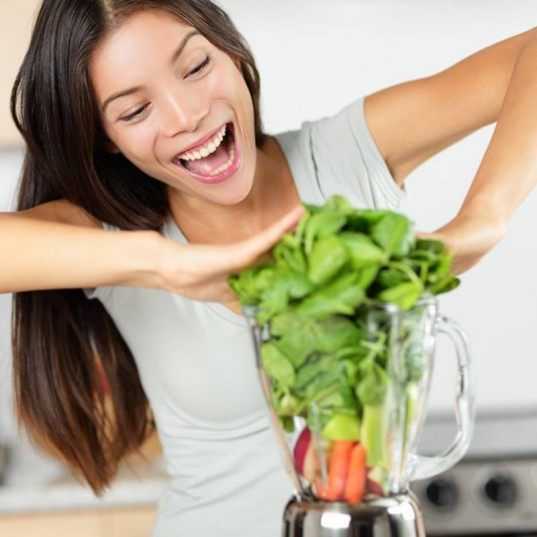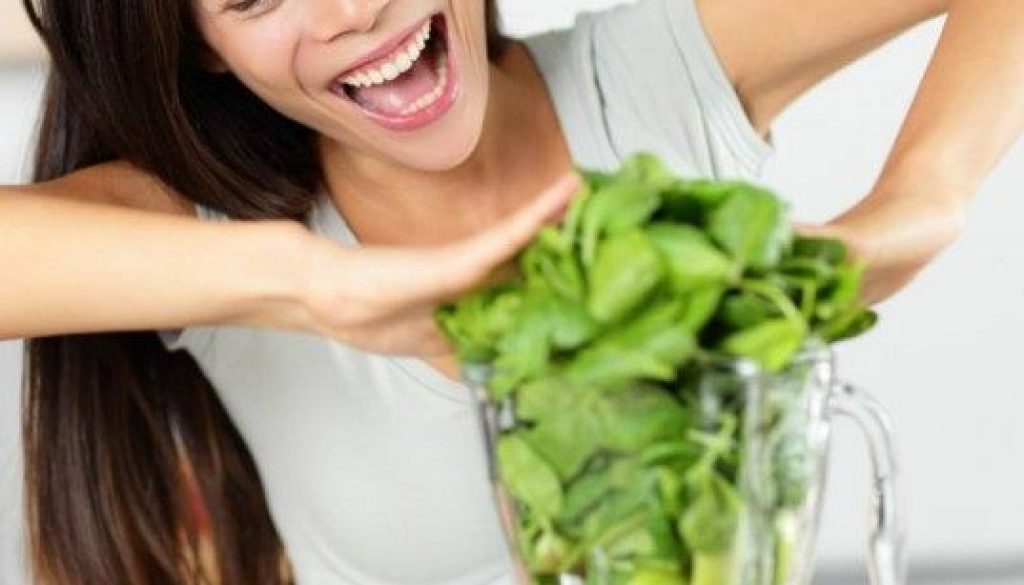Have You Heard? Blending Is the New Black
Earlier this week, while out to dinner with the girls, the topic of juicing came up.
Brands, recipes, and touted health claims just short of offering the holy grail of youth and vitality were shared with excitement!
Just like my friends, I’m sure you too are probably in the midst of the juice craze haze. Don’t get me wrong, juicing is a great alternative for people who aren’t keen on eating their fruits and vegetables. It enables those who wouldn’t normally eat plants to receive nutrients such as vitamins, minerals, phytochemicals, enzymes, and antioxidants.
That being said, I just have one qualm with juicing! When you juice your fruits and vegetables, you also remove all of the beneficial fiber, leaving you left with…well, just juice.
Extracting the juice may be beneficial for those whose digestive tracts can’t handle fiber. But if you don’t have this problem, then juicing may not be for you.
This leaves the majority of us with the one million dollar question: to juice or not to juice? My response is this:
 Try blending smoothies first and here are 5-reasons why:
Try blending smoothies first and here are 5-reasons why:
1. The Beauty of Digestion: Fiber is our Friend
If there is one thing we can count on, it is the regularity of our digestive tracts. Fiber makes this regularity that much more possible. Soluble fiber feeds the natural bacteria or probiotics that live in our gut, while insoluble fiber helps to promote regularity. When we juice fruits and vegetables, we remove all of that fiber-containing goodness. Fiber has been known to not only benefit digestion but also decrease cholesterol levels and the risk of developing heart disease.
2. Keep the Absorption of Nutrients in Balance
When we drink just the juice of plants, we also ingest everything in the juice at a much higher concentration— including sugar. The great thing about fruit is that it’s deliciously sweet but packaged in fiber to slow down the absorption of the sugar. Take away the fiber, and our body has a higher concentration of sugar to absorb, but this time, without a fiber buffer to help keep blood sugar and hormone levels, such as insulin, in balance. Keeping sugar and insulin levels stable can help prevent inflammation and chronic diseases like Type 2 Diabetes.
3. Drinking a Smoothie Will Keep You Feeling Full LONGER
During your busy day, do you find yourself trying to eat healthy foods that also keep you feeling satisfied? In comparison to drinking just juice, smoothies will help you do just that. Smoothies that contain healthy protein (nut butters & yogurt), fat (coconut milk, ground seeds), and carbohydrates (fruit with fiber included!) will provide more bulk to what you are eating. Devouring a nutrient-packed smoothie for breakfast, for example, will take up more room in your stomach than simple juice, thus curbing those mid-morning feelings of hunger.
4. Burn MORE Calories
The ease at which our body digests and absorbs the foods we eat depends on the food itself. For example, foods that are high in protein take more energy to digest than carbohydrates, while carbohydrates take more energy than fats. This is called the Thermic Effect of Food. The more energy it takes to digest food, the more calories our body will burn. When the foods we eat are rich in protein and fiber, the body uses more energy for digestion, while in the process burning more calories.
5. Synergistic Effects of Whole Foods
Nature creates food in ready-made nutrient-rich packages that our body’s innate wisdom knows how to optimize to the fullest. These nutrients, enzymes, phytochemicals, and bioactive compounds work synergistically, or more effectively together as a whole, rather than individually. By extracting only certain parts of the plant, our body does not receive all the nutrition it could as if it were eaten in its entirety.
Now that you are familiar with all the health benefits of blending, you are probably wondering where to go from here? With all the blenders on the market, how can you find the best blender for you? No matter your lifestyle, budget or eating preference there is a perfect blender out there waiting just for you!
Types of Blenders
The great thing about blenders is that there are only a few types to choose from, which helps to narrow down the choices in an already overflowing product market.
Countertop Jar or Jug Blenders
Jar or jug blenders are those you commonly see sitting on the countertop, usually with a glass, plastic, or stainless steel container. Sizes can range anywhere from the personal 8-ounce jar to a larger 60-ounce model.
Tips to remember:
- When buying a blender for smoothies, look for a jar that has a pouring spout. This makes serving much easier and less messy.
- Glass, plastic, or stainless steel? When deciding on the type of jar, think about what is best for you, your lifestyle, and your wallet.
- Plastic jars may be cheaper but are prone to staining and scratching.
- Glass jars are more durable and therefore tend to be more expensive. Glass is also heavier and may be
too bulky to handle for some consumers. - Stainless steel jars are also sturdy but due to their high durability, they tend to be more expensive.
- Look for blenders with a stainless steel blade! This makes crushing ice and/or frozen foods effortless. Additional features that claim to blend foods more efficiently or have a setting made for frozen drinks are a luxury but not a necessity.
- If you are creating a smoothie for one, then a smaller volume personal blender would be far more suitable than a larger one. If you make morning smoothies for you and a small army (a.k.a your family), a larger version could make your life that much easier.
Professional or Multifunction Blenders
Professional blenders take the cake in versatility. They live up to their name in that they can perform many culinary tasks such as blending, creaming, chopping, puréeing, etc. Taking the place of many kitchen appliances, these blenders offer more options than the countertop blender.
Tips to remember:
- Make sure you have space for a professional blender. Some run a bit larger due to their ability to multi-
task. However, since it can replace other appliances you may have, a professional blender could also save space by allowing you to get rid of the appliances you will no longer need. - Professional blenders are definitely pricier. If you are interested, consider it a long-term investment and remember that it will take the place of many other individual appliances.
Immersion or Hand-Blenders
These blenders are not so much used for blending smoothies but more commonly used on the stovetop for puréeing cooked foods and creaming soups.
Finding the Perfect Blender: Let’s Go Shopping!
Got an idea of which blender is right for you? Let’s see what other consumers had to say about the highest-rated professional and countertop (standard and personal-size) blenders on the market! I rated these blenders based on a combination of customer reviews found on Amazon as well as this month’s Top Ten Best Blenders Reviews website. While reading this summation, it’s important to remember that it’s just a guide and not a steadfast rule! Especially when reading reviews, keep in mind that every individual’s experience is different.
Best of luck on your path to smoothie stardom and optimal health!
Reference List
Amazon. (2014). Retrieved August 9, 2014, from http://www.amazon.com/
Blenders: Top 10 Best Blenders Reviews. (2014). Retrieved August 10, 2014, from http://www.top10bestblendersreview.com/



